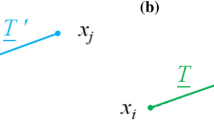Abstract
The fatigue damage mechanisms of concrete under repeated loads are studied. Based on the results of fatigue tests of concrete beam specimens, new fatigue phenomena and process are found and a computing formula is put forward. The physical meanings of the formula are explained from the standpoint of mesoscopic fracture mechanics and damage mechanics. This formula could be used to predict the fatigue life or remaining life of concrete constructions.
Access this chapter
Tax calculation will be finalised at checkout
Purchases are for personal use only
Preview
Unable to display preview. Download preview PDF.
Similar content being viewed by others
References
C.L. Monismith, “Asphalt Mixture Behavior in Repeated Fracture” IER Report TE 66–6 University of California, Berkeley, 1966.
C.L. Monismith, “Flexibility Characteristics of Asphalt Paving Mixture”, Proc. Asso. of Asphalt Paving Tech., Vol. 27, 1958, pp. 74–106.
M.A. Miner, “Cumulative Damage in Fatigue”, Trans. ASME, Vol. 67, A159, 1945.
A.A. Griffith, “The Phenomenon of Rupture and Flow in Solids”, Phil. Trans. Royal Soc., London 221A, 1920–1921, pp. 163–198.
P.C. Paris, “The Fracture Mechanics Approach to Fatigue”, Proc. of 10th Sagamore Army Mete. Rese. Conf., (Aug. 1963), Syracuse Uni. Press.
R.G. Forman, V.E. Kearny and R.M. Engle (1967), “Numerical Analysis of Crack Propagation in Cycle-Loaded Structures”, Jnl. Bas. Engng., ASME Trans. Series D. 89, 459,
M.F. Kaplan, “Crack Propagation and Fracture of Concrete”, Jour, of ACI, Proc. Vol. 58, No.5, Nov. 1961
V.S. Ramachandran, R.F. Feldmen and J.J. Beaudoin, CONCRETE SCIENCE — Treatise on Current Research, pp. 83.
S. Benouche, “Modélization de l’endommagement du béton hydraulic par micro fissuration en compression”, Thèse 3ème cycle (Paris VI — ENSET), 1980.
Author information
Authors and Affiliations
Editor information
Editors and Affiliations
Rights and permissions
Copyright information
© 1989 Springer-Verlag New York Inc.
About this paper
Cite this paper
Binsheng, Z., Zhaohong, Z., Keru, W. (1989). Fatigue Rupture of Plain Concrete Analysed by Fracture Mechanics. In: Shah, S.P., Swartz, S.E. (eds) Fracture of Concrete and Rock. Springer, New York, NY. https://doi.org/10.1007/978-1-4612-3578-1_6
Download citation
DOI: https://doi.org/10.1007/978-1-4612-3578-1_6
Publisher Name: Springer, New York, NY
Print ISBN: 978-0-387-96880-3
Online ISBN: 978-1-4612-3578-1
eBook Packages: Springer Book Archive




